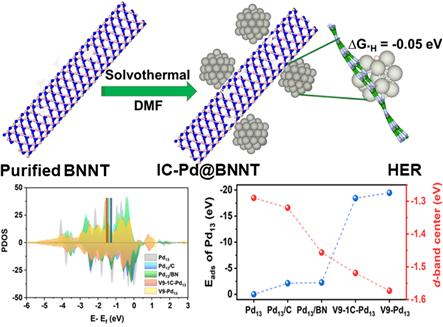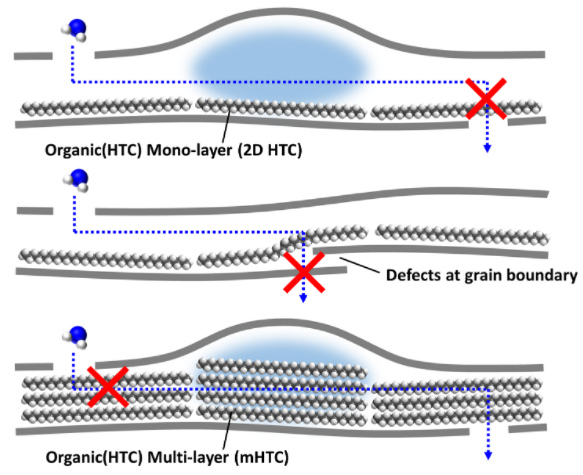News
Space Material Boron Nitride Nanotubes, Hydrogen Production by Water Electrolysis in the Moon.
A research team led by Professor Myung Jong Kim from the Department of Chemistry at Gachon University, in collaboration with researchers from the Korea Institute of Science and Technology (KIST), has developed an innovative catalyst that surpasses the performance of commercial platinum catalysts. This new catalyst, created by combining dodecahedral palladium nanoparticles with boron nitride nanotubes, enables the production of hydrogen through water electrolysis. Thanks to the chemical stability of boron nitride, the catalyst maintains its effectiveness even after 40,000 cycles of experiments, boasting a high Faradaic Efficiency of 98.96%.
Considering the presence of water in the form of ice on the lunar surface, the ability to electrolyze water to produce hydrogen fuel using this catalyst represents a significant advancement in space energy technology, potentially facilitating human habitation on the Moon.
Boron nitride nanotubes alone lack catalytic properties. However, when combined with palladium nanoparticles at the vacancy defects on their surface, the charge transfer enhances the catalytic activity of palladium, resulting in a lower overpotential compared to commercial platinum catalysts.
As leading nations intensify their space development efforts, moving beyond simple exploration to resource extraction and commercialization, boron nitride nanotubes are emerging as crucial materials for space applications. Their chemical stability, high thermal conductivity, strength, and lightweight characteristics make them suitable for various components in spacecraft and spacesuits. Unlike Earth, the Moon lacks a magnetic field to shield against radiation, making radiation shielding materials essential to protect both humans and electronic devices.
The findings of this research were published in the May issue of the internationally renowned journal ‘Applied Catalysis B: Environmental and Energy’ (IF: 22.1, top 0.9% IF). The first authors of the study are Dr. Venkateswarlu Sada from the Department of Chemistry at Gachon University and Dr. Sooyeon Kim from KIST. The corresponding authors are Professor Myung Jong Kim from Gachon University and Principal Researcher Sangsoo Han from KIST.
헤럴드 경제 기사: 우주형 소재 보론 나이트라이드 나노튜브, 달에서 물 분해로 수소생산
Considering the presence of water in the form of ice on the lunar surface, the ability to electrolyze water to produce hydrogen fuel using this catalyst represents a significant advancement in space energy technology, potentially facilitating human habitation on the Moon.
Boron nitride nanotubes alone lack catalytic properties. However, when combined with palladium nanoparticles at the vacancy defects on their surface, the charge transfer enhances the catalytic activity of palladium, resulting in a lower overpotential compared to commercial platinum catalysts.
As leading nations intensify their space development efforts, moving beyond simple exploration to resource extraction and commercialization, boron nitride nanotubes are emerging as crucial materials for space applications. Their chemical stability, high thermal conductivity, strength, and lightweight characteristics make them suitable for various components in spacecraft and spacesuits. Unlike Earth, the Moon lacks a magnetic field to shield against radiation, making radiation shielding materials essential to protect both humans and electronic devices.
The findings of this research were published in the May issue of the internationally renowned journal ‘Applied Catalysis B: Environmental and Energy’ (IF: 22.1, top 0.9% IF). The first authors of the study are Dr. Venkateswarlu Sada from the Department of Chemistry at Gachon University and Dr. Sooyeon Kim from KIST. The corresponding authors are Professor Myung Jong Kim from Gachon University and Principal Researcher Sangsoo Han from KIST.
헤럴드 경제 기사: 우주형 소재 보론 나이트라이드 나노튜브, 달에서 물 분해로 수소생산
Boron nitride nanotubes for radiation shielding and energy storage.
Professor Myung Jong Kim's research team in the Department of Chemistry has developed a high-efficiency energy storage technology using Boron Nitride Nanotubes (BNNT) and tungsten composites. This research was supported by the Ministry of Science and ICT (MSIT) and the National Research Foundation of Korea (2020R1A2C1101561). The findings were published in the June issue of Composites Part B: Engineering (IF: 12.7, top 0.3%). The paper, titled "Alternative inner filling and outer surface coating of BNNT by Tungsten(VI) oxide for supercapacitor electrode," was co-authored by Hong-Gu Kim (Ph.D. candidate) and Dr. Chandan Kumar Maity (Gachon University), with Professor Myung Jong Kim as the corresponding author.
Developed nations are accelerating space exploration, aiming not just for exploration but for resource extraction and commercialization, addressing humanity’s final frontier. In this context, Boron Nitride Nanotubes (BNNT) are gaining attention as a space material due to their radiation shielding capability, chemical stability, high thermal conductivity, strength, and light weight—properties essential for spacecraft and space suit components. Unlike Earth, which has a protective magnetic field, the Moon and outer space lack such protection, exposing both humans and electronic devices to radiation.
Professor Myung Jong Kim's team developed a method to selectively fill the inside or coat the outside of BNNT with tungsten oxide (WO3). BNNT shields neutrons, while tungsten atoms shield gamma rays. As a result, the BNNT-tungsten composite effectively shields both neutrons and gamma rays, making it a promising material for space and defense applications (Patent No. 10-2024-0019043).
Additionally, this composite enhances energy storage in supercapacitors. Filling BNNT with tungsten oxide improves stability, while coating it enhances energy storage capacity. BNNT also facilitates electrolyte movement and stabilizes tungsten oxide, significantly improving electrochemical performance.
Experiments showed that BNNT coated with WO3 exhibited high electrochemical activity (856 F/g). As a supercapacitor, it achieved a specific capacitance of 137 F/g and an energy density of 52 Wh/kg. The devices retained about 81% of their capacity over time, while BNNT filled with WO3 maintained approximately 94%, highlighting BNNT’s crucial role in stabilizing WO3.
These characteristics are particularly significant for space exploration, where reliable and efficient energy storage systems are essential. The research team plans to continue exploring BNNT-based materials to develop even more efficient and durable energy storage systems.
가천대 소식: 화학과 김명종 교수 연구팀, 보론 나이트라이드 나노튜브(BNNT)와 텅스텐 혼성체를 이용한 고효율 에너지 저장기술 개발
Developed nations are accelerating space exploration, aiming not just for exploration but for resource extraction and commercialization, addressing humanity’s final frontier. In this context, Boron Nitride Nanotubes (BNNT) are gaining attention as a space material due to their radiation shielding capability, chemical stability, high thermal conductivity, strength, and light weight—properties essential for spacecraft and space suit components. Unlike Earth, which has a protective magnetic field, the Moon and outer space lack such protection, exposing both humans and electronic devices to radiation.
Professor Myung Jong Kim's team developed a method to selectively fill the inside or coat the outside of BNNT with tungsten oxide (WO3). BNNT shields neutrons, while tungsten atoms shield gamma rays. As a result, the BNNT-tungsten composite effectively shields both neutrons and gamma rays, making it a promising material for space and defense applications (Patent No. 10-2024-0019043).
Additionally, this composite enhances energy storage in supercapacitors. Filling BNNT with tungsten oxide improves stability, while coating it enhances energy storage capacity. BNNT also facilitates electrolyte movement and stabilizes tungsten oxide, significantly improving electrochemical performance.
Experiments showed that BNNT coated with WO3 exhibited high electrochemical activity (856 F/g). As a supercapacitor, it achieved a specific capacitance of 137 F/g and an energy density of 52 Wh/kg. The devices retained about 81% of their capacity over time, while BNNT filled with WO3 maintained approximately 94%, highlighting BNNT’s crucial role in stabilizing WO3.
These characteristics are particularly significant for space exploration, where reliable and efficient energy storage systems are essential. The research team plans to continue exploring BNNT-based materials to develop even more efficient and durable energy storage systems.
가천대 소식: 화학과 김명종 교수 연구팀, 보론 나이트라이드 나노튜브(BNNT)와 텅스텐 혼성체를 이용한 고효율 에너지 저장기술 개발
Gas barrier Graphene with blocking pores.
The research team of Professor Myung Jong Kim in Department of Chemistry developed a technology of filling the nanopores while maintaining the unique characteristics of graphene by utilizing the self-aligning behavior of organic materials on the graphene surface, through cooperative research with the research team of Dr. Seok-Hoon Ahn in Korea Institute of Science and Technology, and the research team of Professor Young-Jong Kang in Hanyang University.
In order to cover the nanopores of graphene with aligned organic molecules, the research team of Professor Myung Jong Kim utilized the behavior of organic materials with long chain structure that align well with each other at the molecular level on the surface of graphene, thereby creating nanopores that function as a passageway for gas molecules. By controlling the thickness of aligned organic material at nanometer level, the gas barrier property was significantly improved. In addition, the moisture permeability was decreased to 1/100, while the intrinsic transparency and flexibility of graphene has remained the same. -Nano Letters 22, 286-293 (2022)
이데일리 뉴스: 그래핀 상용화 막았던 '나노구멍' 해결책 찾아
In order to cover the nanopores of graphene with aligned organic molecules, the research team of Professor Myung Jong Kim utilized the behavior of organic materials with long chain structure that align well with each other at the molecular level on the surface of graphene, thereby creating nanopores that function as a passageway for gas molecules. By controlling the thickness of aligned organic material at nanometer level, the gas barrier property was significantly improved. In addition, the moisture permeability was decreased to 1/100, while the intrinsic transparency and flexibility of graphene has remained the same. -Nano Letters 22, 286-293 (2022)
이데일리 뉴스: 그래핀 상용화 막았던 '나노구멍' 해결책 찾아
.png)




.png)
.png)

